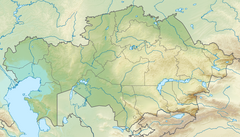Baikonyr
| Baikonyr Байқоңыр | |
|---|---|
 2016 ISS image with the Baikonyr flowing into lake Shubarteniz from the southeast | |
| Location | |
| Country | Kazakhstan |
| Physical characteristics | |
| Source | Ulytau |
| • coordinates | 48°00′18″N 66°21′41″E / 48.00500°N 66.36139°E |
| • elevation | 449 m (1,473 ft) |
| Mouth | Shubarteniz |
• coordinates | 47°30′42″N 65°02′43″E / 47.51167°N 65.04528°E |
• elevation | 125 m (410 ft) |
| Length | 235 km (146 mi) |
| Basin size | 4,940 km2 (1,910 sq mi) |
| Discharge | |
| • average | 0.85 m3/s (30 cu ft/s) |
The Baikonyr or Baikonur (Kazakh: Байқоңыр; Russian: Байконыр) is a river in the Ulytau District, Karaganda Region, Kazakhstan.[1][2] It has a length of 235 km (146 mi) and a drainage basin of 4,940 km2 (1,910 sq mi).[3][4]
The river flows by Baikonur village.[2] Ancient petroglyphs have been found on rocks along both banks of river Baikonyr.[5]
Course
[edit]The Baikonyr river has its origin at the confluence of rivers Kurambai (Kuanbai) and Aktas in the southwestern slopes of the Ulytau Range. It heads roughly southwestwards within a valley having a maximum width of 2 km (1.2 mi) to the northeast of the Kalmakkyrgan. In its final stretch it flows roughly westwards, bending northwestwards to end up in the southeastern end of the Shubarteniz lake, to the south of the mouth of the Zhymyky.[4][6]
The Baikonyr is fed by the winter snows. In the spring its water is fresh. But it turns salty as the flow diminishes and in the summer it dries largely up, breaking up into small pools.[3][6]
See also
[edit]References
[edit]- ^ "L-41 Topographic Chart (in Russian)". Retrieved 9 September 2022.
- ^ a b "L-42 Topographic Chart (in Russian)". Retrieved 9 September 2022.
- ^ a b Kazakhstan National Encyclopedia / Ch. ed. B.O. Jakyp. — Almaty: « Kazakh encyclopedia» ZhSS, 2011. ISBN 9965-893-64-0 (T.Z.), ISBN 9965-893-19-5
- ^ a b Google Earth
- ^ "Victor Novozhenov, Petroglyphes of Saryarka. Аlmaty 2002". Archived from the original on 10 January 2022. Retrieved 9 September 2022.
- ^ a b L-41-XII. пикет №11. Кулжамбай - Topographic Chart
External links
[edit]- Сердце Казахстана — Улытау (in Russian)
- Пресс-релиз — Аральское море (in Russian)
- Туристско-научная экспедиция - Казахстанская правда (in Russian)
- История Улытау (in Russian)

